Exotic blooms, vibrant colors, and easy to care for, these flowering houseplants are sure to catch your eye and brighten up your home. Whether you are looking for striking blooms, visual interest, or a fun new plant to enjoy, you will love these wonderful blooming indoor plants.
Keep reading to discover some of the most popular and fascinating flowering houseplants, how to take care of them, and which ones are best for you.
1. African Violets (Saintpaulia ionantha)
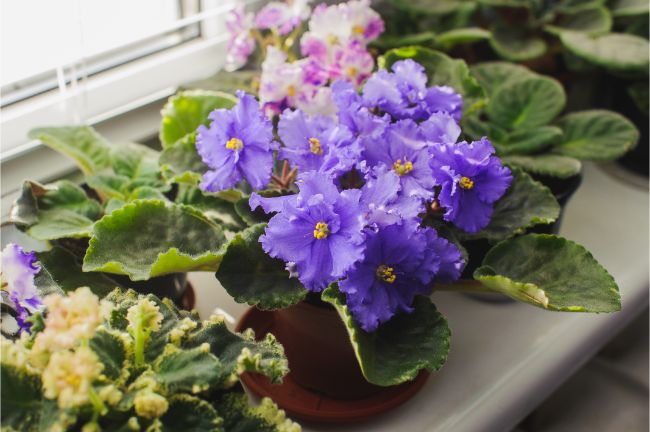
These delightful little plants, also known as Saintpaulia ionantha, top the list for being some of the most beautiful and popular flowering houseplants. Delightful little blooms of purple, white, or blue hover lightly over soft fuzzy leaves. If treated right, these little plants can last for decades and can be propagated into many more African Violets.
Caring for African Violets isn’t too hard so long as you follow the directions. Keep your pot of violets in a small saucer, and water it from the bottom when the soil gets dry.
If the leaves become too wet, they can rot. Fertilize sparingly with African Violet fertilizer. This plant prefers to be rootbound, but it does like to be repotted in fresh soil every year or so. Keep it in bright, indirect light and make sure it gets around 8 hours of darkness every night.
Turn your plant every couple of days to keep the growth even and keep it at room temperature. Propagating African Violets is easy. Just cut off a leaf and plant it into moist soil, where it will grow roots and become a new plant.
2. Flaming Katy (Kalanchoe blossfeldiana)

If you want a non-fussy flowering houseplant, consider a kalanchoe or flaming katy. Kalanchoes are flowering succulents, so you won’t need to spend a lot of precious time watering or fussing over their care. Flaming pink, white, yellow, or orange blooms top off large glossy green leaves, giving the plant its nickname, flaming katy.
Kalanchoes like lots of bright, indirect light. You’ll want to keep them in a pot with good drainage. Water them thoroughly and allow all of the excess water to drain so the roots do not rot. Then you won’t need to water your plant again until the soil is completely dry.
If your kalanchoe stops blooming, you’ll need to give it 12 hours of light and 12 hours of complete darkness for 6 to 8 weeks to encourage it to bloom again. The vibrant blossoms are well worth the little bit of work it takes to get them to bloom. Read more about flaming katy care here.
3. Moth Orchids (Phalaenopsis)
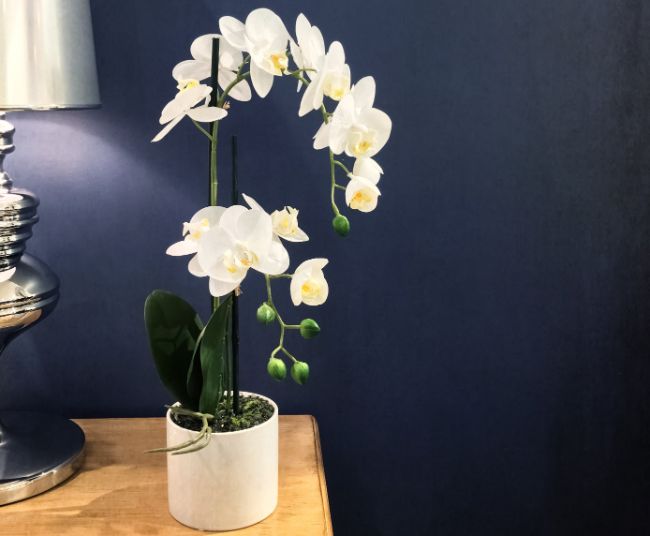
The phalaenopsis orchid is the perfect orchid for beginners. With gorgeous delicate flowers growing along arched branches, they make the perfect highlight to any space. These showy flowers will definitely delight and getting them to bloom is just a matter of setting the right conditions.
Phalaenopsis orchids typically bloom in spring and summer, but in the right conditions, they can bloom repeatedly all year round. Each flower can last for several months and each branch can hold as many as 20 blooms.
Phalaenopsis orchids prefer a bright room but not direct sunlight so you may want to place yours near an eastern facing window. Turn your orchid from time to time so that it grows evenly.
Take care to only water it once the potting media has dried out, as they can easily develop root rot if overwatered. Fertilize every 1-2 weeks with very dilute orchid fertilizer while the plant is growing. When it is blooming or resting, you can cut back to once a month. Read everything you need to know about caring for phalaenopsis orchids here.
4. Tufted Airplant (Guzmania)
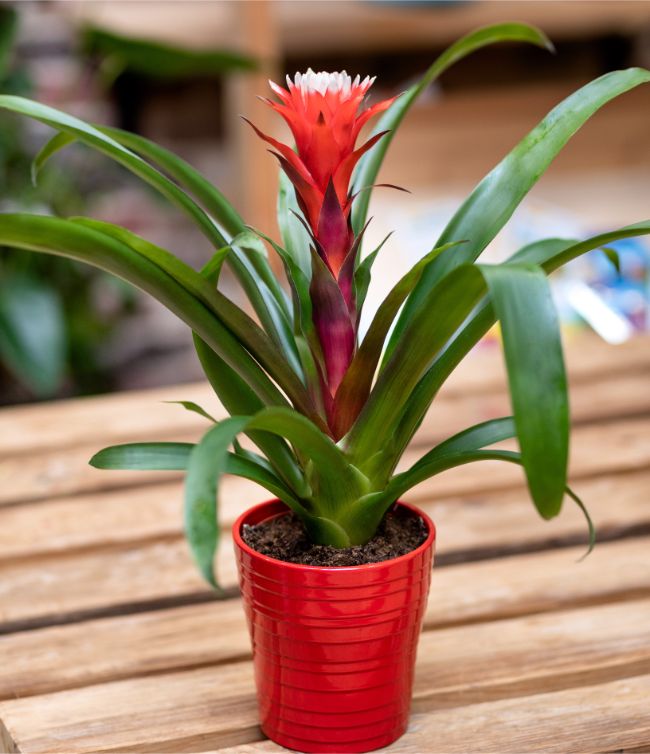
This striking houseplant is a bromeliad and is related to the pineapple. These plants are hardy and easy to care for, with a fascinating bloom. The brightly colored flower grows out of the center of the plant, and at its base is a cup that is shaped like a vase or urn.
Once a month, water the plant thoroughly, flushing out the cup at the same time. Allow the excess water to drain and put just a little bit of water back into the plant’s cup. You may need to mist your plant once or twice a week. Keep your plant in bright, natural light but not in direct sunlight. You’ll enjoy it’s strikingly bright colors.
Read more about how to care for Guzmania plants in this article I wrote which covers all aspects of their care.
5. Lipstick Plant (Aeschynanthus radicans)

Aeschynanthus radicans, or lipstick plants, are trailing, flowering houseplants with unique blossoms that look like lipstick tubes. Lipstick plants cheer up the room and add a dash of color when potted in a hanging basket in a bright kitchen window.
Lipstick plants like medium to bright indoor light; the better the lighting, the better the blooms turn out. Use a light potting soil that drains well. Don’t overwater or the roots will quickly rot. Fertilize once a month in spring and summer and keep the plant at room temperature. This plant gives a lot of pop for a little effort.
6. Goldfish Plant (Columnea gloriosa)
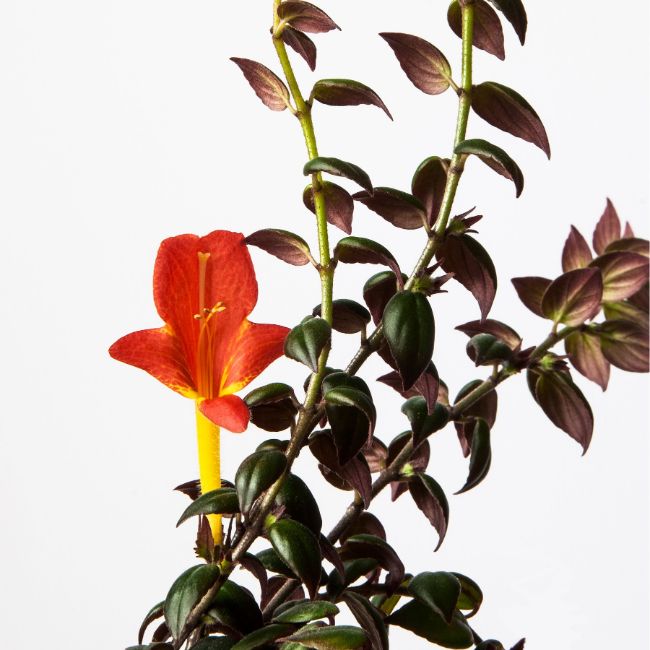
The goldfish plant, also known as columnea gloriosa, bears striking reddish orange flowers that resemble leaping goldfish. This is a beautiful plant that requires just a little skill to grow but will make a fun conversation piece.
Columnea gloriosa is worth the effort. Place your goldfish plant beside, rather than in front of, a bright window because it prefers bright sunlight but not direct sunlight. It doesn’t like to be too hot or too cold, so keep it between 65-75F (18-24C).
Coarse sphagnum moss is a great growing medium for this plant as it allows the water to drain away quickly. Avoid overwatering, but remember the plant needs high humidity. Fertilize every two weeks in spring and summer. Keep the goldfish plant relatively root bound and pinch back blossoms after the blooms are done.
7. Hindu Rope Plant (Hoya carnosa Compacta)

Hindu rope plant is a very unique looking plant that displays best in a hanging planter to show off its rope-like features. Dark green waxy leaves twist around dangling vines, giving this plant its name, Hindu rope. When it matures, it will produce star-shaped pink flowers that begin as burgundy buds.
In the summer, water your Hindu rope deeply but infrequently. Water less in the dormant winter months. Bright light will help the plant bloom frequently. You may need to prune your Hoya carnosa compacta often, however, pruning must be done carefully. When pruning, make sure to disinfect shears first, and prune with care so as not to damage any leaves. Injuries to the leaves can cause the plant to die back.
8. Crown Of Thorns Plant (Euphorbia milii)
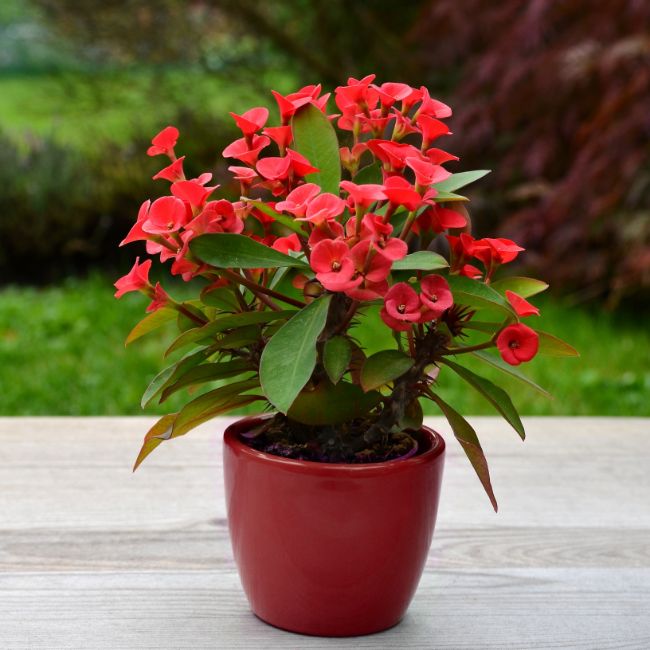
Crown of Thorns, also known as Euphorbia Milii, is a tropical, flowering houseplant that originated in Madagascar. Mythology says this plant was woven into the crown of thorns worn by Jesus Christ on the cross, but more likely, another plant was used for that purpose.
That being said, this plant bears thorns along its woody stems that resemble the thorns in the crown. This plant has been widely cultivated, creating many varieties of colors and shapes. Leaves are sporadic on this houseplant, showing off its thorny stems. Brightly colored flowers adorn the top.
Euphorbia milii enjoys bright light and well-draining soil. Try a cactus potting mix or blend good potting soil with plenty of perlite or vermiculite to enhance drainage. Water thoroughly and allow the soil to dry out completely before watering again.
Avoid any contact with the milky sap of euphorbia milii, as it is toxic and can cause temporary blindness. This may not be an appropriate plant for houses with small children and pets.
9. Guppy Plant (Nematanthus)
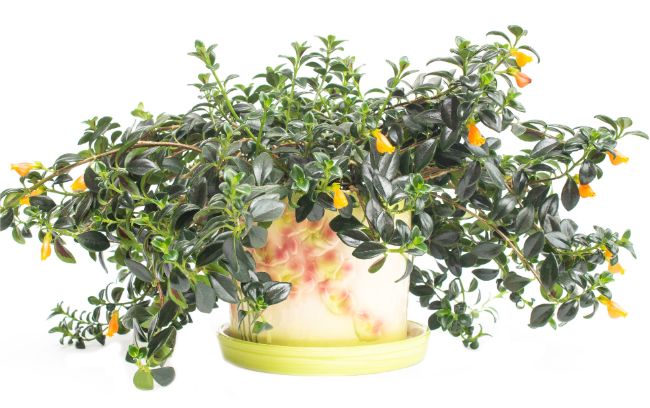
Not to be confused with the goldfish plant, the guppy plant, or nematanthus, grows cute little orange flowers resembling small fish. Nematanthus is a bit easier to grow than columnea gloriosa but has a more cute rather than striking bloom.
To care for the guppy plant, keep it in bright light. A hanging basket with well-draining potting soil works great. As a relative of the African Violet, you’ll want to water thoroughly and allow soil to dry to the touch in between waterings. Fertilize once a month in spring and summer.
10. Shrimp Plant (Justicia brandegeeana)
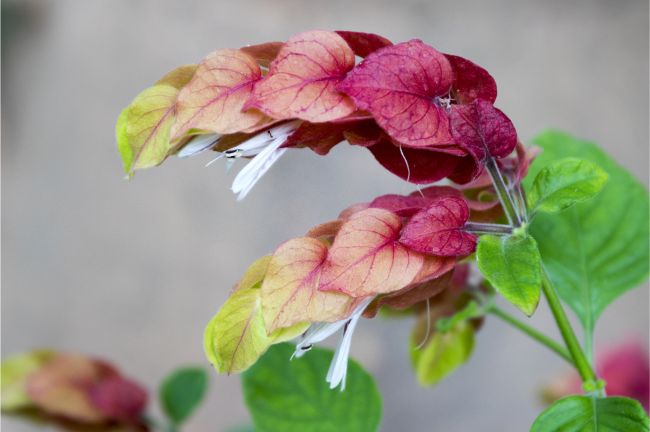
The Mexican Shrimp plant, or Justicia brandegeana, isn’t a very fussy plant at all. With just a little love, it will bloom all winter long, producing long red flowers resembling shrimp. This is a unique plant you won’t find in every home, but it will bring a splash of bright color to your kitchen or living room.
Give your shrimp plant some good potting soil and fertilize it occasionally. Prune your plant whenever it starts to look scraggly or leggy to encourage bushier growth. Keep your Mexican Shrimp Plant in sandy or loamy soil and water sparingly. Allow it to dry out before you water it again.
11. Jasmine (Jasminum polyanthum)
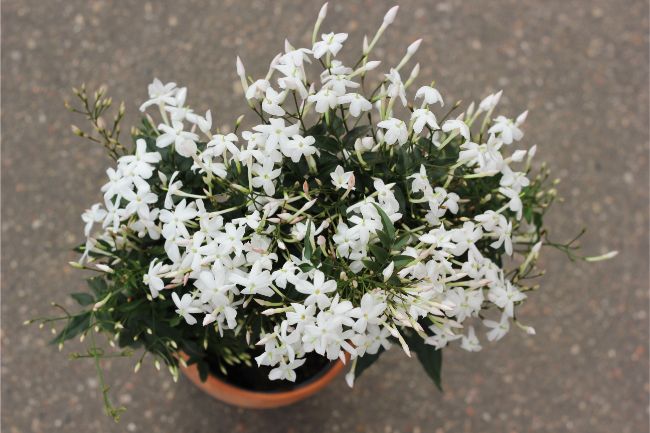
There are many varieties of jasmine, but Jasminum polyanthum is most commonly grown as a houseplant. Small white flowers emit a sweet aroma.
This climbing plant should be pruned often to keep it under control. You may also need to prune the roots when repotting in the spring. Jasmine only needs fertilized twice a year, although you can encourage growth by feeding liquid fertilize every few weeks during the spring and summer.
Jasmine likes to be in part sun to shade, so it will do well indoors in bright light. Do not allow the soil to become soggy but do keep it somewhat moist. In warmer climates, this plant can become invasive when planted outdoors.
Indoors, Jasmine plants make delightful flowering houseplants for those looking to fill their home with a beautiful fragrance. I’ve written a helpful article about jasmine plant care if you’d like to learn more.
12. Peace Lily (Spathiphyllum wallisii)
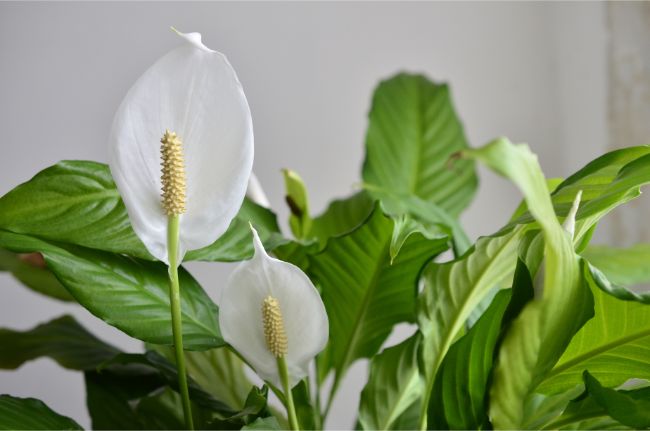
Who doesn’t love a peace lily for its large beautiful blooms and low-maintenance lifestyle? Spathiphyllum is not a true lily but is related to the calla lily. Large white flowers that appear as a modified leaves give the peace lily a beautiful and elegant appearance.
Although they come in a variety of sizes, peace lilies are often at least three feet tall, making them a great floor plant. Sadly, peace lilies are poisonous to both cats and dogs.
Some of the benefits of growing peace lilies is that they are adaptable and easy to care for. They grow just fine in darker spaces and can even do well under fluorescent lights, such as in a hospital or office space.
Peace lily leaves will turn yellow if the light is too bright, so keep them out of direct sunlight. You’ll want to keep your peace lilies at room temperature, and away from cold drafts.
Your peace lily will tell you when it needs a drink by dropping its leaves slightly. You’ll want to water just before this happens, and provide moderate humidity. Peace lilies recover well from drought so don’t panic if you forgot to water it for a while. Give it a good drink and watch it perk back up. Remember that peace lilies can be toxic to dogs, cats, and small children, so be careful. Read more about peace lily care here.
13. Flamingo Flower (Anthurium)
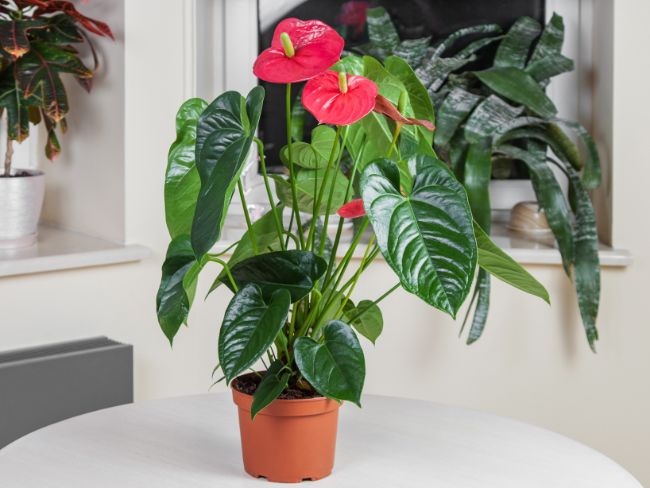
The anthurium symbolizes hospitality and inspires happiness and warmth. These easy-to-care-for flowering houseplants will bloom year-round under the right conditions. You’ll love its glossy heart-shaped leaves which are crowned with red heart-shaped blossoms.
Your anthurium can live in low light, but it won’t bloom unless it has lots of bright light. Water your anthuriums to keep the soil moist but not be soggy. Anthuriums also love high humidity, so a kitchen or bathroom is a great place to keep your plant. Otherwise, try to maintain at least average humidity levels to maintain glossy leaves.
Keep your anthuriums away from drafts and cold air and fertilize it a couple of times a year. If the blooms are lagging a bit, try fertilizing a little more often. If the leaves turn yellow, it’s getting too much light. And if the plant isn’t blooming or the flowers stay green, it isn’t getting enough. Cut off dead leaves and flowers to encourage your anthurium to bloom some more. Read more about anthurium care here.
14. Purple Shamrock (Oxalis Triangularis)
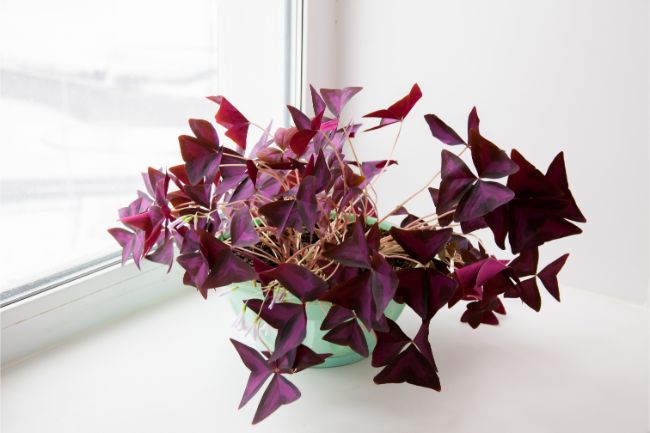
This plant is sometimes called purple shamrocks because of its surprising triangular purple foliage. With delicate movement like tiny butterflies, the leaves and blooms of the oxalis triangularis close up at night, and open wide again in the morning sun. Oxalis triangularis plants are easy to care for, and make beautiful flowering houseplants, even for beginners.
You may see the leaves move throughout the day to follow the sunlight across the room. With the right care, this plant can live for many years and might become your next family heirloom. Be careful around small children and animals, as this plant has been known to be toxic, although the bitter taste is a good deterrent.
Oxalis triangularis likes moderate to bright light. Water it thoroughly, then allow it to dry out before watering again. Purple shamrocks only needs fertilized every couple of months, and is happy in any good potting soil.
If you’ve neglected your plant and it dies, don’t worry. Allow your soil to dry out completely, and after a few days, water it again. When the conditions improve, your oxalis triangularis should be able to resurrect itself with new growth from the bulbs.
15. Cape Primrose (Streptocarpus)
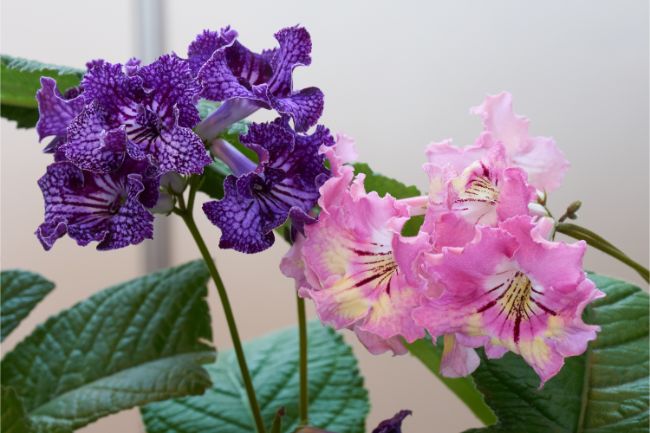
Cape Primroses, also known as streptocarpus, have been one of my favorite flowering houseplants for many years. This South African native comes in a variety of colors and shapes to adorn your home with beauty and joy. Cheery flowers seem to just pop up over long velvety green leaves.
One of the benefits to growing streptocarpus is its ability to bloom in low light. An east or west window is the perfect spot for these beauties. Yellowing leaves will warn you that the light is too high, while dark green leaves thrive in lower lights. Periodically, pinch off any spent leaves or blooms to keep your plant looking healthy.
When watering, err on the side of being too dry rather than too wet. The leaves will stain if they get wet, so water only the soil and not the leaves. Cape Primroses prefer cooler weather, between 60-70°F (16-21°C).
If your plant gets too warm, it could collapse and die, so you may want to keep your Stretocarpus in an air-conditioned room in the summertime. Fertilize sparingly and dilute the recommended amount of liquid houseplant fertilizer in half.
16. Christmas Cactus (Schlumbergera)
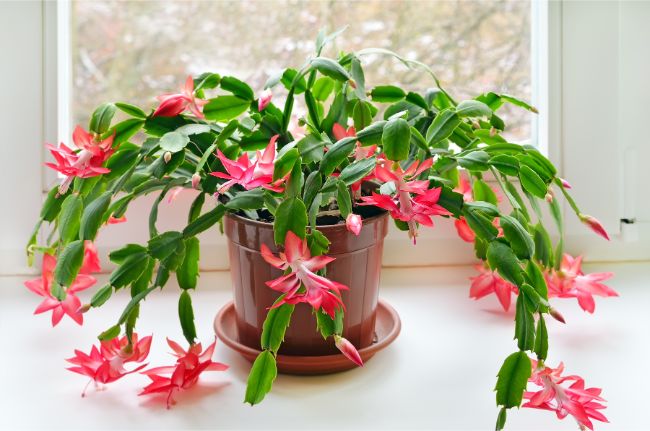
Schlumbergera gets its name because it blooms just in time for Christmas. Each branch can grow up to three feet long and is decorated with a pink, purple, yellow, white, or red blossom. Christmas cacti make wonderful flowering houseplants and can bloom for several weeks under the right conditions.
This plant is a popular holiday gift with its gorgeous colored blooms and segmented branches, but you don’t have to be that person that discards the Christmas cactus when the Christmas season is over
Christmas cacti love consistency. Keep the temperatures around 65°F (18°C), as large swings can cause the blooms to drop prematurely. Keep the soil evenly moist, but not soggy or dry. This plant loves humidity, so please mist it often while it is blooming, or increase humidity in any of these ways. It likes some direct sun – an east- facing window is just right. Fertilize every two weeks starting when buds begin to form.
After your plant is done blooming, it’s time to repot it with fresh soil. Keep them in a cool room, around 50°F (10°C) and keep the soil just barely moist. Once new growth begins, you can force it to bloom by moving it to a slightly warmer area and giving it 10 hours of light and 14 hours of darkness for six to eight weeks. When you start to see some buds, you can care for the plant as you did while it was blooming. It should bloom again in another six weeks.
17. Poinsettia (Euphorbia pulcherrima)
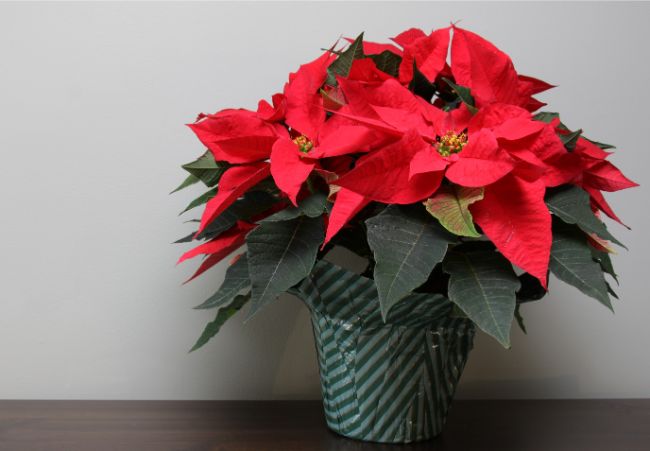
Bright red and white blooms of the poinsettia point us right to the Christmas season. More recently, these pretty flowering houseplants have been cultivated in additional, vibrant colors. If you’ve been gifted a beautiful poinsettia, you don’t have to toss it out with the wrapping paper and ribbons. Keep it healthy and it will bloom for you again next year.
Poinsettias prefer loose, well-draining soil. Don’t water until the surface of the soil feels dry, then water it thoroughly until water runs out the bottom of the pot. Don’t let the plant sit in water, though. If the plant wilts due to lack of water, it will drop leaves. You can nurse it back to health by the following season, if desired.
Keep the plant at room temperature and away from drafts, which will also cause leaves to drop. Keep watering your plant until April, then slowly water it less and allow it to go somewhat dormant. In the summer, move it outside, and pinch off the tops so that the plant doesn’t get too tall and spindly.
When it starts to cool, you’ll need to bring your poinsettia back inside, and begin giving it 12 to 15 hours of complete darkness each night. When buds appear around November, you can begin leaving your plant out again and it should bloom in time for the Christmas season.
18. Kaffir Lily (Clivia miniata)
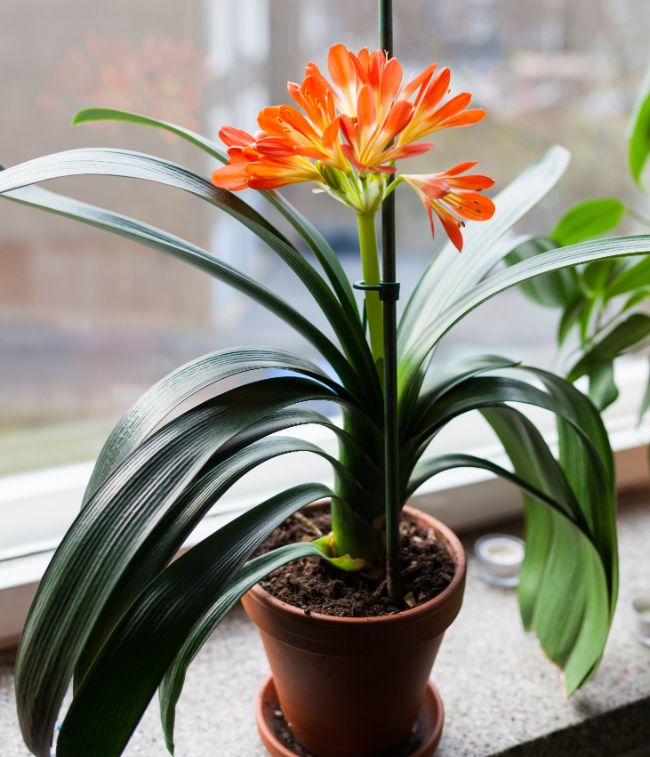
The bush lily, kaffir lily, or clivia miniata makes for a beautiful addition to your home with its bell-shaped flowers perched over top of dark green arched leaves. Orange petals with yellow centers are the most popular colors, although this plant is becoming more available in other colors, as well.
The kaffir lily takes two to five years to mature and grow to 18 inches tall. It may not bloom until the second or third year. Although it is beautiful, it is considered toxic to pets; if you have kafir lilies be sure to keep them out of reach.
Kaffir lilies are easy to care for. They like bright indirect sunlight, however, in low light situations, the foliage can still grow but the plant will not bloom. Only water your kaffir lily when the top one inch of soil is dry to the touch.
Remove dead blossoms so that the plant does not produce berries. In order for your plant to bloom in the spring, you’ll want to give it a rest period over the winter months.
Move it to a room that is cool, somewhere between 50-65°F (10-18°C). Do not water your kaffir lily unless it begins to droop, then water it lightly. These plants enjoy being root bound and prefer not to be disturbed. You will only need to repot them every few years after the plant has finished blooming.
19. Dendrobium Nobile Orchids
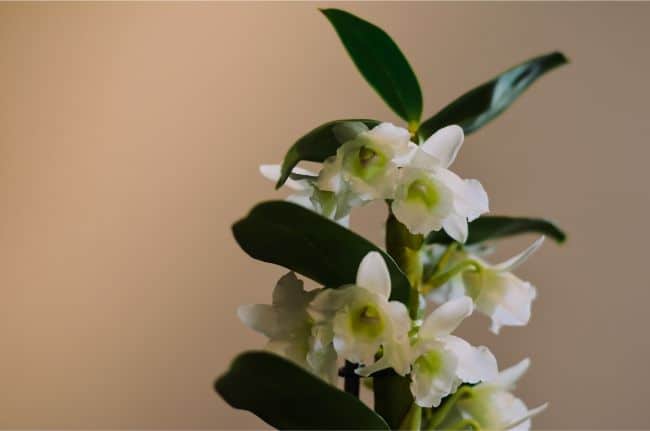
These popular orchids are very easy to grow, inexpensive to purchase, and are simply beautiful flowering houseplants. They grow large flowers in small clusters along their canes. Blooms last for at least six weeks, but under ideal conditions, they may last as many as twelve weeks.
Like any orchid, you’ll want to plant them in a growing medium that mimics their natural habitat. Since they are ephiphytes, this means you’ll want to use a mix of bark, moss, or perlite or simply a commercial orchid potting mix. Keep them in a sunny window, but you may need to protect them from direct sun.
These orchids can tolerate colder temperatures than most, however, they do not tolerate frost. Water weekly during the growing season. In fall and winter, reduce watering. Water just enough so that the plant does not shrivel. Most of the year, the dendrobium nobile orchid is comfortable at room temperature. But to set it for blooming, over the winter period, you’ll want to give it slightly cooler temperatures at night.
Although this plant is less sensitive to temperatures and humidity than other orchids, it is still susceptible to problems such as fungus. You can reduce the chance of fungus by keeping air circulating in the room where you keep your orchid but avoid putting the orchid directly in a draft.
Have You Chosen Your Flowering Houseplants Yet?
With so many beautiful flowering houseplants to choose from, you’re sure to find the one that suits your home. Do you want a very unique plant like the euphorbia milii or the hoya carnosa compacta? Or would you rather a popular tried-and-true African violet?
Are you ready to try your hand at nurturing a stunning orchid, or would you rather the easy-to-care-for peace lily? If you are looking for something a little bit playful, maybe you would rather have a lipstick plant or a guppy or goldfish plant.
Then again, maybe you prefer the stunning guzmania for your home. With these stunning flowering houseplants, you’ll brighten your home, engage your visitors, and have wonderful blooms to enjoy.





